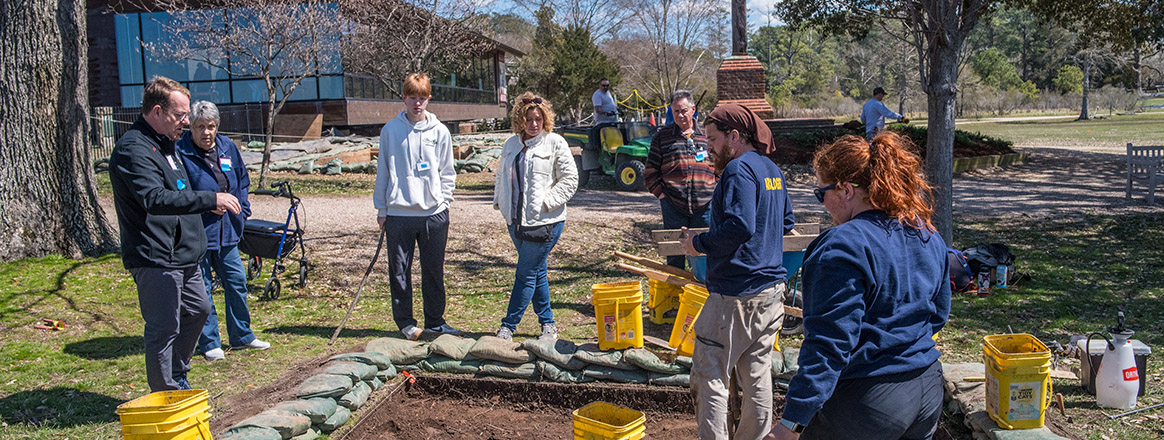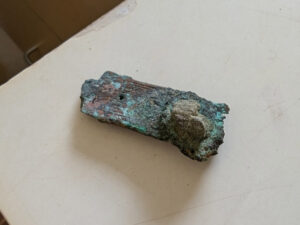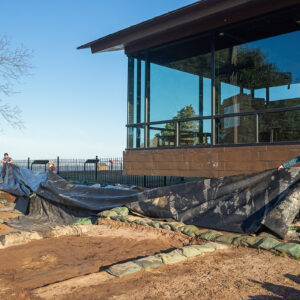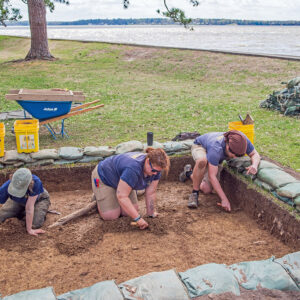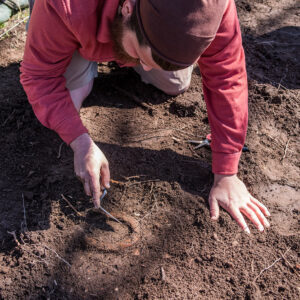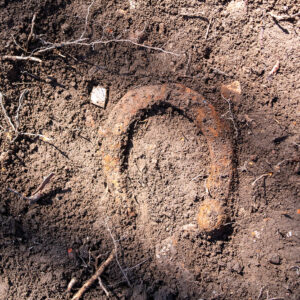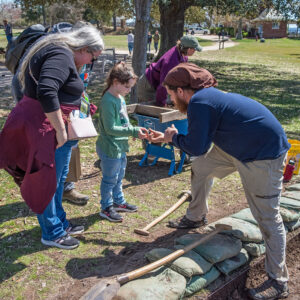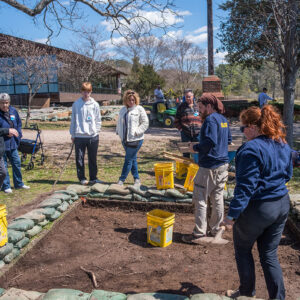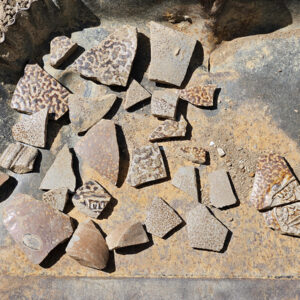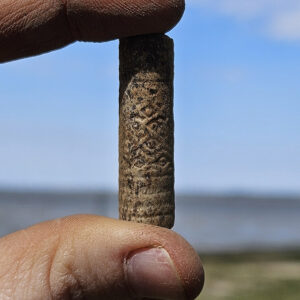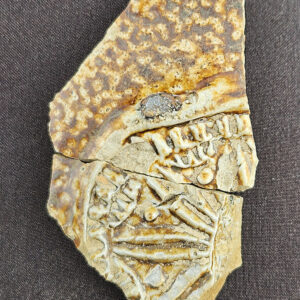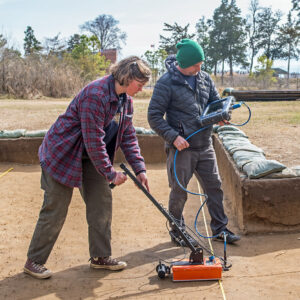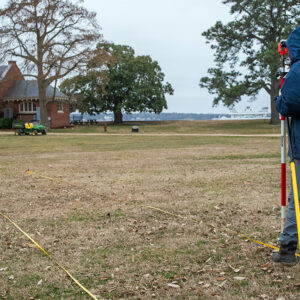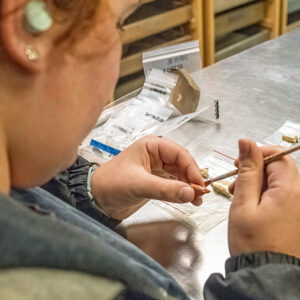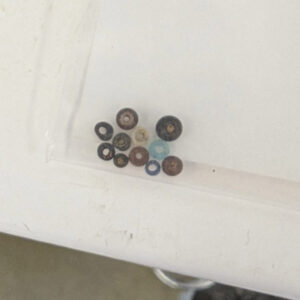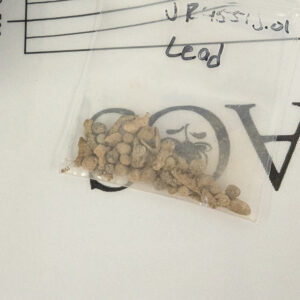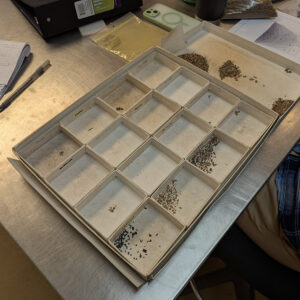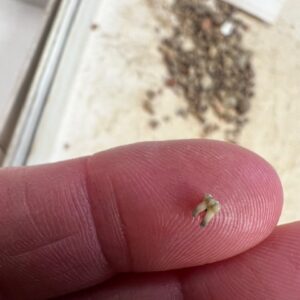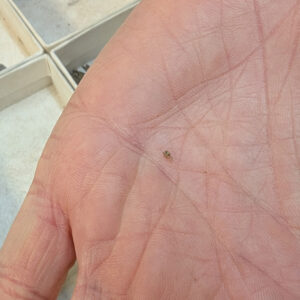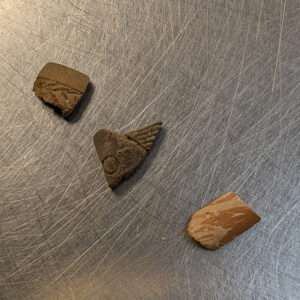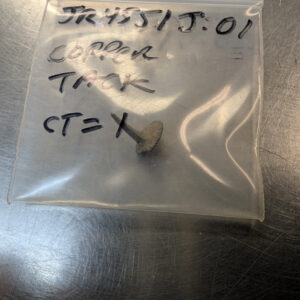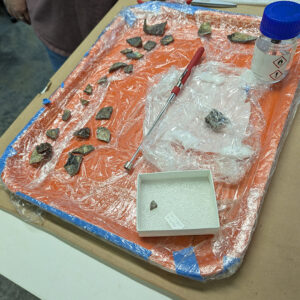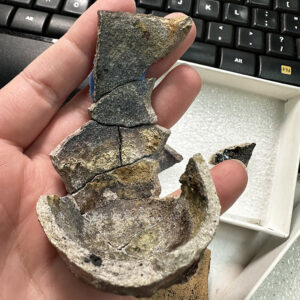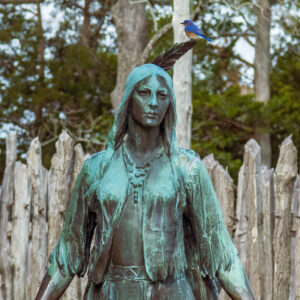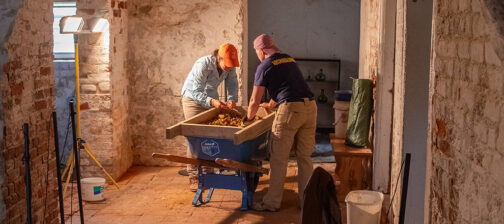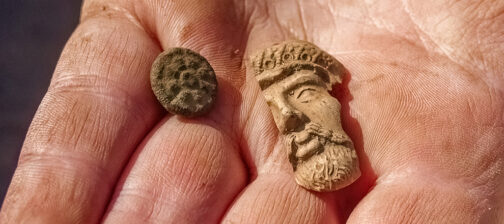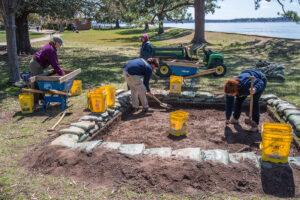
The archaeology team is welcoming the onset of spring and the opportunity to get back outside. They have resumed their excavations close to the Archaearium, working both just south of the museum and opening new squares closer to the river, on the other side of the walking path. The same goals remain as when these excavations were paused for the winter…find the bounds of the burial ground centered on Statehouse Ridge, explore and follow the 17th-century features found south of the Archaearium, and more generally explore this part of Jamestown, inside and on the fringes of Smithfield, where no archaeology has been conducted before. To that end, this month the team surveyed the line of 5′ x 5′ squares that will be excavated in the next few months in a north/south line straight across Smithfield from the Archaearium to the Dale House. Will more burials turn up? Did the colonists construct buildings in this area? The team is eager to investigate this area as it has become increasingly flood-prone. If there are features here, they want to find and study them before the floods damage them further. In the new excavations southwest of the Archaearium a horseshoe, Frechen stoneware, Portuguese faience, and an ornate pipe stem are among the finds this month.
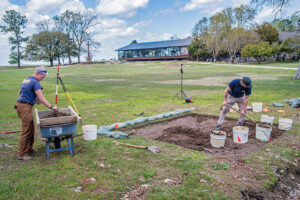
On the southeast edge of Smithfield, the ground stayed dry long enough at the artillery barracks site for the team to make progress on the excavations there. Staff Archaeologists Caitlin Delmas and Gabriel Brown picked up where the team left off last season in an on-again/off-again project that is at the mercy of the weather and tides. They were unable to make much progress before the excavations were again put on hold due to soil saturation. A series of square features found here by a ground-penetrating radar (GPR) survey are in approximately the right location to be Confederate barracks featured on a Civil War map of Jamestown Island. These same barracks were later used by Union soldiers to house enslaved people who escaped to the island in order to free themselves after the Union captured it in 1862.
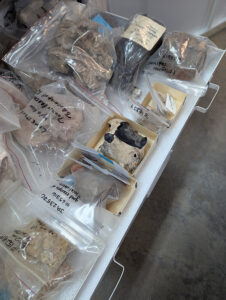
In the Vault, the curatorial team has started work on the Reference Collection for geological materials. There are at least 100 different stone types in the collection, and each type will be represented by at least one artifact in one of the Vault cabinets. The curators will collaborate with geologists from William & Mary to further identify and source the various types of stones that have been found on the site. Determining where the rocks came from is of special interest to us, as we already know that a number of stones were brought to Jamestown from England and elsewhere as ballast, and were either discarded or used as architectural building material on the site.
Perhaps the most well known example of foreign rocks at Jamestown is the multitude of Bermuda limestone that our archaeologists have found on the site. The Sea Venture, one ship of nine sent with 600 passengers to resupply the struggling Jamestown colony in 1609 was shipwrecked on Bermuda by a hurricane. During their months-long stay there, they built two ships to continue their journey to Virginia, likely laden with Bermuda limestone as ship’s ballast. This was the first time that colonists bound for Jamestown arrived in Bermuda first, so the presence of the stone in a sealed (undisturbed) archaeological context provides a nice terminus post quem (TPQ…a Latin phrase used in archaeology meaning the earliest possible date) for that context of May 1610, the month the shipwrecked colonists arrived in Virginia.
In February of last year geologists from William & Mary began analyzing stones found in the bottom of the Governor’s Well (late 1610s). Their preliminary findings indicate the stones originate from southern England and they are currently working to narrow this down even further. For photos and a bit more info on the collaboration with William & Mary, read February 2024’s dig update. Another example of the Jamestown team working with outside experts to determine the origin of stone can be seen in the effort to source the Knight’s Tombstone, prominently placed in the colony’s second church (c.1617 to c.1639). A wide variety of laboratory tests were conducted to identify the stone’s source, even including the study of fossils found in thin section samples of the tombstone. The analysis was performed by Dr. Marcus M. Key of Dickinson College and Rebecca K. Rossi of California Geological Survey. Their methods and results can be read here.
Dr. Eva Johanna Holmberg of the University of Helsinki visited Jamestown this month to study the medical tools in the collection as part of her research into the experience of bodily pain in the colony. Her examination of these artifacts, currently held in the Vault and on display in the Archaearium museum, complements her study of primary source materials. The research centers on the experiences of three leaders of the colony, George Percy, Captain John Smith, and Thomas West, Lord de la Warr. This research is part of a broader project entitled ‘Experiencing Agony: Pain and Embodiment in the British Atlantic World, 1600-1900’. You can read more about Dr. Holmberg’s research here.
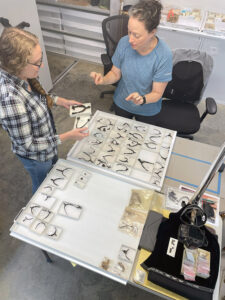
Much progress was made on artifacts related to horses this month, building towards choosing which items will be represented in the Reference Collection. Sara Rivers-Cofield, Curator of Federal Collections of the Maryland Archaeological Conservation Lab, visited Jamestown in 2021, to analyze the collection of horse furniture and spurs as part of her ongoing research. Ms. Rivers-Cofield took photos and measurements of horse-related artifacts including bridle and saddle parts, bits, horseshoes, spurs, and decorative ornaments that adorned various parts of a horse’s tack. Now that her analysis is wrapping up, Associate Curator Janene has begun entering the data and photos that were taken into our database. This month, she finished updating the database records for metal leather ornaments, and volunteers rebagged each artifact with a paper tag containing the artifact’s context and other identifying information. Next, Janene will incorporate any leather ornaments that were not part of the initial study into both our database and Ms. Rivers-Cofield’s dataset.
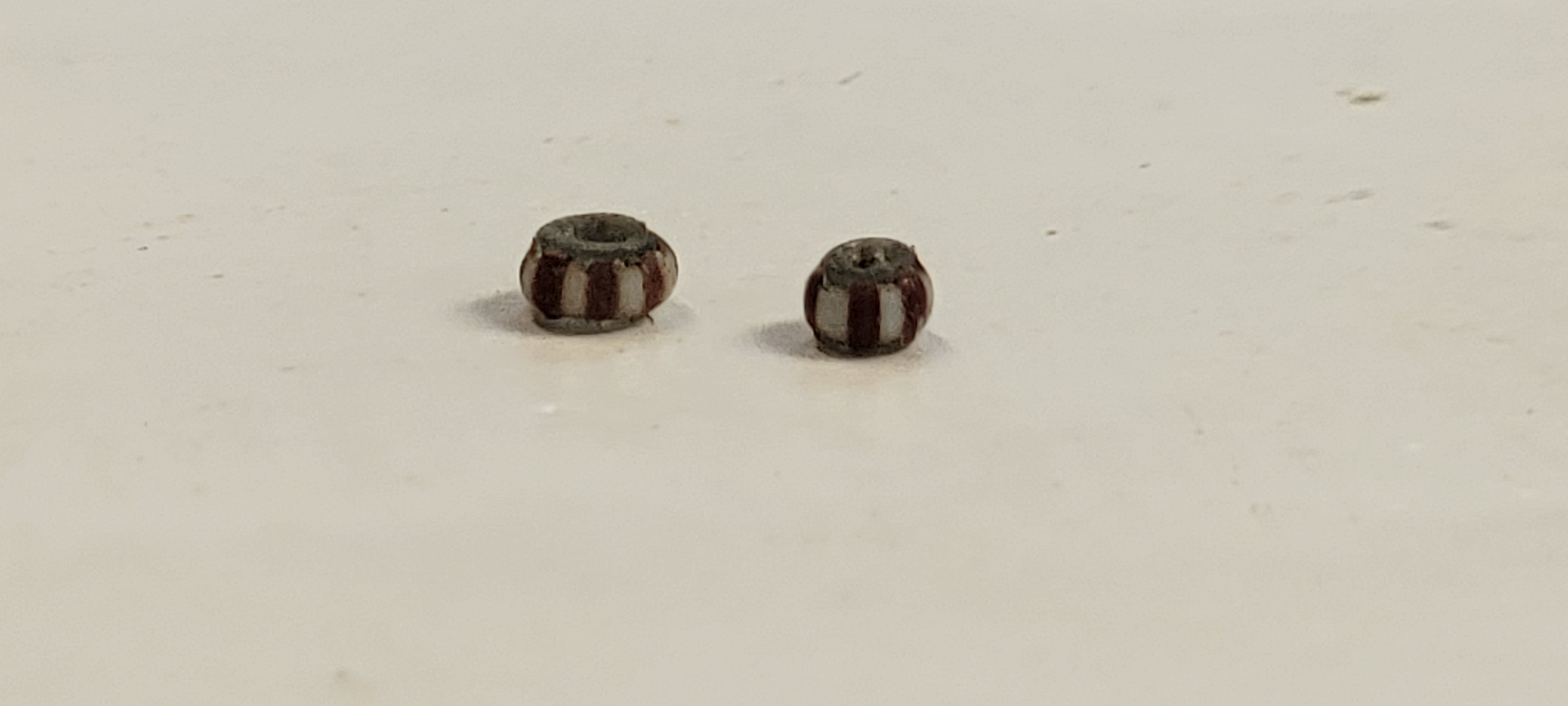
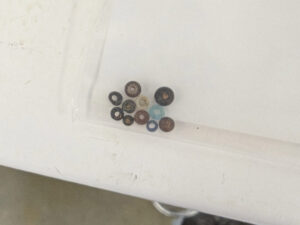
This month members of the archaeology and curatorial teams joined volunteers in picking through material excavated from excavations near the Seawall in 2021. Archaeological Field Technicians Hannah Barch and Josh Barber found striped seed beads while picking through material from a midden near the eastern bulwark. Several seed beads have been found in this material, and this month a number of small lead shot, pipe fragments, and a copper tack have been found as well. These artifacts will be cataloged in our collections database and the data will accompany dig reports currently being written about those features.
Processing continues on material excavated from the fort’s first well, discovered in the center of James Fort in 2006. Assistant Curator Magen Hodapp, our resident zooarchaeological expert, is working through layer “H” of the well and is sorting bones into broad categories such as “fish” and “mammals”. She will then further categorize them as much as possible before handing the bones over to outside experts for further classification. Curatorial Intern Lindsay Bliss is picking through material from this feature, also referred to as the John Smith Well because it was constructed during his leadership either in late 1608 or early 1609. Lindsay’s efforts this month have yielded aglets and animal bones.
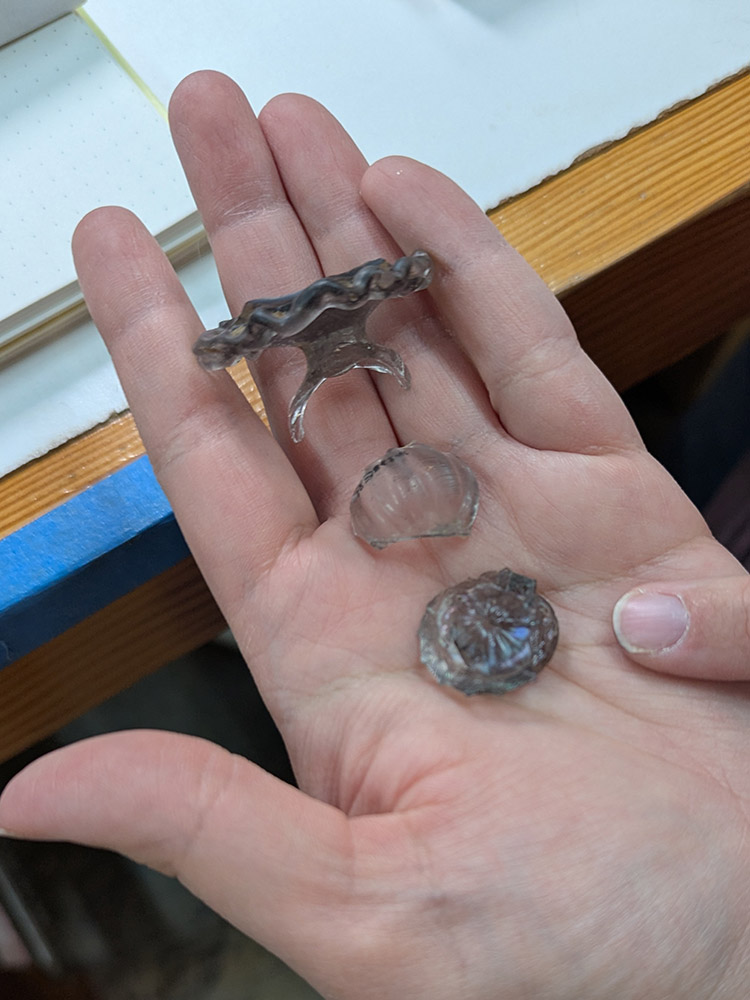
This month while sorting material from excavations just south of the Archaearium, a volunteer alerted the curators to a hollow stem fragment of a wine glass! The piece is one of three belonging to the same vessel and was designed by John Greene of the London Glass Seller’s Company. This type of wine glass was produced in Venice until 1666 and then in London from 1667-1673. Another very similar vessel was found during earlier excavations.
Work on the Hessian Refractory crucibles is wrapping up. Assistant Curator Lauren Stephens is working on adhering the last mendable sherds found by Senior Curator Leah Stricker. The material used to mend ceramics is an acrylic resin called Paraloid B-72. It is dissolvable in acetone, which means that it can be made in varying levels of stickiness and used on different types of artifacts.
One vessel in particular has really taken shape since the crucible reference collection project began last year, from just a few sherds attached to a base, to a nearly-complete object. One final sherd that belongs to this vessel was recently identified, meaning that the already-mended crucible must be taken apart in order to fit the last sherd in place, and then all sherds must be re-mended. Critically, B-72 can be removed using acetone, meaning it is reversible to allow mends to be taken apart if needed.
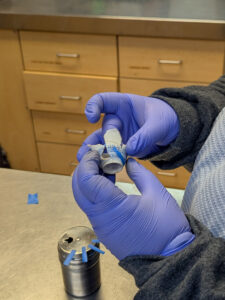
Assistant Conservator Jo Hoppe is preparing ceramics for inclusion in an exhibit to be hosted at Jamestown Settlement entitled “Following the Dragon: Chinese Ming Porcelain in Early Jamestown“. Jo is assessing the condition of all the artifacts slated for the exhibit. This is standard procedure for any part of the collection leaving our control, so that if something were to be damaged its condition prior to the handoff was documented. She is also mending some of the ceramics, using a common household item — painter’s tape — to temporarily hold pieces in place during the process. Jo uses the same reversible adhesive that Lauren is using on the crucibles — Paraloid B-72.
Senior Conservator Dan Gamble continues his research into book hardware, metal pieces used to support, decorate, and keep books closed. Because the pages of books in this period were made out of animal skin that would expand when exposed to moisture in the air, the books they were a part of expanded with them. Latches, catches, corner pieces, and purely decorative pieces are among the artifacts in the Jamestown collection. One avenue of Dan’s research is an attempt to determine where book hardware (and thus perhaps the book) originates from by determining its chemical composition. All of the hardware is made of copper alloy but the type of non-copper elements and their proportions may give clues to the hardware’s origin. The team has decided to use pXRF to determine the hardware’s chemical makeup. pXRF is a non-destructive process in which X-rays are emitted at an object and the elements comprising the object emit a unique response in return, allowing their identification. But before this test can be done, Dan is removing the protective coating (Paraloid B-72) on the hardware using acetone so that the coating itself isn’t interpreted as part of the object’s composition. We’ll give the findings of these tests in a future dig update.
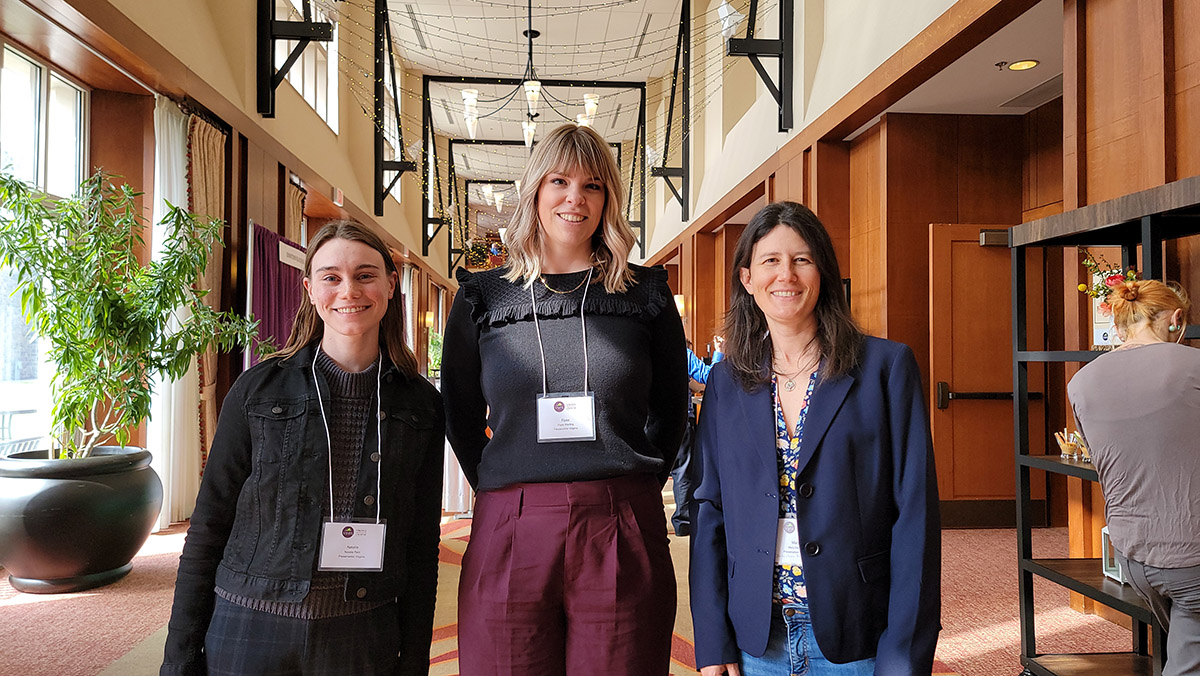
Senior Staff Archaeologist Mary Anna Hartley and Staff Archaeologist Natalie Reid attended the Virginia Association of Museums (VAM) Conference in Blacksburg, VA, on March 15-17. They attended sessions led by the descendants of the individuals enslaved on the Rock Spring Plantation, today known as the Reynolds Homestead, and by WWII historians who discussed how their museums struggle with identifying which topics, ideas, and objects to exclude due to lack of space, time, or bandwidth, etc. Natalie attended a session co-presented by our colleague Elyse Werling, Curator of Collections at Preservation Virginia, on textile display and many other fascinating panels. The keynote speaker was Dr. Ashley Spivey, who discussed the history and purpose of the American Graves Protection and Repatriation Act and summarized the updated regulations. Mary Anna and Natalie met with several museum professionals and VAM Board members to discuss some of the challenges we are face from more frequent flooding of areas not yet investigated archaeologically.
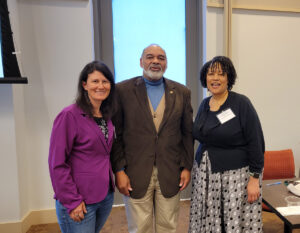
Following the VAM Conference, Mary Anna attended the 15th Annual Lemon Project Symposium on March 21st here in Williamsburg. Dedicated to scholarship and activism focusing on the 300-year relationship between African Americans and the College of William & Mary, The Lemon Project: A Journey of Reconciliation symposium featured talks on Black history in our region, community organizing, and descendant representation. Mary Anna had to privilege to attend a panel co-hosted by our colleague Dr. Lisa Winn Bryan, Community Outreach Manager at Preservation Virginia, entitled “Reclaiming Our Story”. One of the presenters was Rev. Dr. James Harrison from Surry County, a good friend of Mary Anna’s since the late 2000s when Dr. Harrison worked with her mother at the Surry Historical Society.
related images
- Archaeological Field Technicians Hannah Barch, Josh Barber, Ren Willis, and Staff Archaeologist Natalie Reid uncover the Archaearium excavations for the first time after the winter pause.
- Archaeological Field Technicians Ren Willis, Hannah Barch, and Josh Barber excavate one of the new squares just southwest of the Archaearium.
- Archaeological Field Technician Josh Barber excavates a horseshoe found in one of the new excavation squares southwest of the Archaearium.
- Close-up of the horseshoe found in a square southwest of the Archaearium
- Archaeological Field Technician Josh Barber shares a sherd of ceramic he found with a young visitor.
- Archaeological Field Technicians Josh Barber and Hannah Barch share their findings with visitors to the excavations southwest of the Archaearium.
- Sherds of Frechen and Beauvais stoneware found by the archaeological team in the excavations southwest of the Archaearium.
- Sherds of Portuguese faience found in one of the new excavation squares southwest of the Archaearium. These date to ca. third quarter of the 17th century.
- A pipe stem, possibly Dutch, found in the excavations southwest of the Archaearium.
- A Frechen stoneware medallion found in the excavations southwest of the Archaearium
- Staff Archaeologist Gabriel Brown and Archaeological Field Technician Ren Willis at the excavations near the Godspeed Cottage. Ren is using a Munsell color chart to classify a soil sample taken from a burn feature.
- Archaeological Field Technician Eleanor Robb and Staff Archaeologist Gabriel Brown conduct a GPR survey of the excavations close to the Godspeed Cottage.
- Members of the archaeology team survey the 5’x5′ squares marking where the Smithfield excavations will be conducted this season.
- Archaeological Field Technician Hannah Barch labels and bags artifacts in the lab. She applies Paraloid B-72 as a base for a label on a sherd of ceramic. B-72 is a reversible adhesive so the label can be removed if necessary.
- Archaeological Field Technician Josh Barber examines a tiny artifact he found while picking through objects from excavations near the Seawall in 2021.
- Some tiny beads found by archaeological and curatorial staff while picking through objects found during the Seawall excavations of 2021.
- Shot and other lead objects found by archaeological and curatorial staff while picking through material from the 2021 Seawall excavations.
- A tiny striped bead found by Archaeological Field Technician Hannah Barch while picking through material from excavations near the Seawall
- Curatorial Intern Lindsay Bliss picks through tiny objects from the John Smith Well and then places them in smaller boxes organized by object type.
- Curatorial Intern Lindsay Bliss holds a rodent molar she found while picking through material from the John Smith Well.
- A tiny fish vertebrae found by Lindsay Bliss amongst the John Smith Well objects.
- Pipe fragments found by volunteers picking through objects from 2021’s Seawall excavations
- A copper tack is one of the artifacts found by volunteers picking through material from 2021’s excavations near the Seawall.
- The newest-found sherd of a crucible sits in a box ready to be mended to the rest of the vessel that is in pieces on the orange tray. Because the new sherd couldn’t be mended without first removing other pieces, Lauren used acetone to weaken the B-72 adhesive holding the vessel together.
- A crucible in August 2024, prior to the crucible reference collection project. Just the base and a few other pieces are mended.
- The same crucible in March 2025, nearly complete thanks to the work of the curatorial team during the crucible reference collection project
- A bluebird keeps Pocahontas company on a spring day


